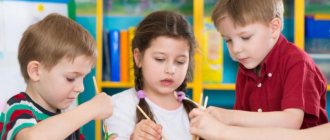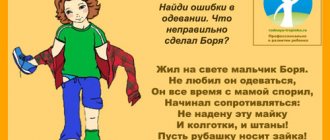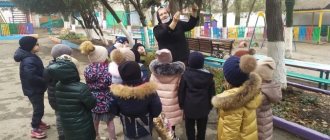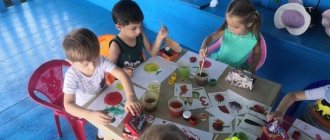Basic principles of organizing the daily routine
Definition 1
Daily routine is a measured order of actions planned for the day.
While the child is in kindergarten, his life activities correspond to a regulated routine. The alternation of educational activities and outdoor games, rest and active wakefulness helps to avoid nervous fatigue in children.
Depending on their age, children are engaged in mastering certain self-service skills and learning to communicate culturally. It is important that in kindergarten the child not only develops, but also satisfies his need for active movements, nutrition, timely rest, etc.
Planning of routine moments in the middle group is based on studies of the physiology of children. Taking into account the age characteristics of the pupils. The basis of the regime are the following principles:
Are you an expert in this subject area? We invite you to become the author of the Directory Working Conditions
- rhythmicity - changing types of activities in accordance with internal cycles characteristic of children 4-5 years old;
- cyclicality – a constant schedule forms a habit and relieves nervous tension;
- alternation of rest and active pastime - throughout the day, outdoor games replace quiet activities, educational activities are replaced by artistic activities, and wakefulness is replaced by sleep;
- flexibility - when the child is tired, he should be able to retire. If he wakes up too early, he engages in quiet games with books and toys;
- gradualism - preschoolers should not be rushed, they should be given the opportunity to independently complete the work they have started;
- individual approach – some children may need additional help and special attention. The teacher must gradually include them in the general rhythm.
Planning the day: first half
A child’s stay in kindergarten can be divided into two periods. The first half of the day is the time before quiet time. After it, the second half of the day begins, ending with the children going home.
Let us list the regime moments in the middle group (according to the Federal State Educational Standard), carried out in the first half of the day:
- Reception of children, independent games (1 hour 20 minutes).
- Charging (10 min.).
- Breakfast (30 min.).
- Educational activities, including preparation for them and breaks between classes (1 hour).
- Walking with dressing (2 hours).
- Return to the group (20 min.).
- Lunch (30 min.).
- Daytime sleep along with preparation for it (2 hours 15 minutes).
First half of the day in the middle group of preschool educational institutions
A child’s stay in a preschool educational institution can be divided into two stages. The first half of the day is preceded by a quiet hour, after which the second half of the day begins, ending with the children going home.
Finished works on a similar topic
Course work Regime moments of the middle group 470 ₽ Abstract Regime moments of the middle group 220 ₽ Test work Regime moments of the middle group 250 ₽
Receive completed work or specialist advice on your educational project Find out the cost
In the middle group, the following routine moments occur in the first half of the day:
- welcoming children and independent play;
- charger;
- breakfast;
- educational activities;
- walk;
- return to the group;
- dinner;
- daytime nap.
In accordance with the plan of routine moments, in the middle group the day begins with the arrival of children at the preschool educational institution. The teacher’s task is to joyfully welcome children and include them in interesting games with classmates. Some children find it difficult to part with their parents, then they need to be distracted: play out a scene with toys, show a flowering plant, offer to look after it.
In order for the children to finally wake up, get a boost of vigor and activity, they do morning exercises. This regime moment in the middle group provides for the mandatory inclusion of running and walking with different formations, jumping, etc. Usually the lesson is conducted to music.
In the middle group, children already have developed basic self-care skills. They know how to wash their face and arms up to the elbow. The teacher needs to ensure that children do not jostle near the washbasins. Great attention should be paid to accuracy.
The teacher strives to create a calm, friendly atmosphere during routine moments. Pupils in the middle group should not be rushed when they are going for a walk and going to bed. At the same time, they are not allowed to be distracted by games and conversations.
Children are taught the following points:
- be located close to a personal locker;
- remember the order of putting on things, which may be hanging on the wall in the locker room;
- fasten buttons yourself;
- turn clothes right side out;
- put on shoes using a special spoon;
- neatly put things in the locker.
Being on duty in the canteen instills in children a responsible attitude towards assignments and a desire to take care of their comrades. The attendants are dressed in aprons and chef's hats, creating additional motivation for them.
Eating presupposes a positive attitude towards routine moments. In the middle group, before meals, children play quiet games or put away toys. The teacher teaches children the culture of behavior at the dinner table. You can learn these rules with the help of special fairy tales, poems, and acting out stories about an ill-mannered bear who does not know how to eat neatly. Correct behavior is reinforced by praise and encouragement from the teacher.
Regime processes in the first half of the day
Summary of the regime processes in the 1st half of the day.
Morning reception
Goal:
to create a cheerful emotional state for the whole day, to ensure a calm separation of children from their parents.
Conduct:
10-15 minutes before I come to the group, ventilate the room, prepare the toys. I greet each child kindly and greet him and his parents with a smile. I ask the parents: “How did the child sleep?”, “How is he feeling?”, “In what mood did he go to kindergarten?” or I ask the child himself: “Well, how are you? Will you play with us today? Then I bring the child into the group and offer him an activity (dolls, cars, cubes, mosaics). During the reception, if the child does not want to part with his parents, I use musical and ).
Washing
Purpose:
to teach children to gently place their hands under the stream of water, to rub their hands, to use soap, to find their own towel, to dry their hands independently, to teach them not to be afraid of water.
Conduct:
While the nanny is putting breakfast on the tables, I call 2-3 children who are eating slowly and say: “Guys, do you want your hands to be clean? Let's wash them." I take the children to the washbasin and say: “We roll up our sleeves so as not to get them wet, and now open the tap with warm water. I make sure (if necessary I help) that the children open the tap. When water flows from all the taps, I use a literary word: Clean water is flowing. We know how to wash with you - We put our hands under the water with a boat (I show it to the children). Now take the soap and lather your hands in a circular motion. They washed their ears with soap, they washed their hands with soap, these are the little hands, little hands, little hands. — We put the hands under the water again and rinse off the soap well. Shake the remaining water into the sink and turn off the tap. Now everyone goes to the towel and wipes their hands dry on all sides; we hang the towel back in its place. So our hands have become clean!
Feeding
Goal:
To provide rational nutrition to all children, teach them to eat correctly, cultivate cultural and hygienic eating habits (eat independently and carefully, use a napkin, do not crumble bread, push in a chair, thank them after eating, rinse their mouth), cultivate a favorable attitude towards eating .
Conduct:
“Children, everyone who has washed their hands, sit down at the tables. Sit up straight, put your legs straight, do not put your elbows on the table. Everyone is sitting upright, Legs are standing together, Eyes are looking at the plate, Elbows are removed from the table, The children are eating quietly. Children! Came to visit today
Not Doctor Aibolit
Came to visit today - Good Appetite! Bon Appetit everyone!" While eating, I make sure that the children hold the spoon correctly, sit up straight, and eat in silence. I tell you how beneficial it is when children eat: they grow quickly and never get sick. I try to convince children who don’t eat that they need to eat at least a little (unless they have a reason not to eat). For those guys who eat slowly or don’t know how to eat, I feed them with a separate spoon. To the child who has eaten, I say: “Dasha, take a napkin and wipe your mouth, don’t forget to say “thank you” and push up the chair.”
Preparing for a walk (dressing)
Goal
: to ensure that all children get ready for the walk in a timely manner;
form the correct sequence when dressing, develop children’s speech (fix the names of items of clothing, actions). Conduct:
Before going out for a walk, I remind the children to go to the toilet. Then I take a subgroup of children and we go out to the locker room together. I begin to dress the children for a walk, observing the principle of gradualness: tights, socks, pants, boots, jacket, hat, jacket, mittens, scarf. During this I use an artistic word: We dress in order, We get used to order. I ask the children: - Danila, what color are your pants? - Vanya, what do we put on our heads? If the children cannot answer, I help them. I encourage the children to dress themselves: “Kolya, show me how you can put on your pants.” — Children, in order for our clothes to be clean, we need to walk carefully and not run through puddles.
Returning from a walk (undressing).
Goal:
ensure timely arrival from a walk, develop cultural and hygienic undressing skills (neatly fold things and put them in the closet, do not jostle near lockers), develop speech (reinforce the names of items of clothing, actions).
Conduct:
I ask all children to wipe their feet when entering the kindergarten (I show how to do this) - How cheerful you all are when you came from your walk! Do you want to go to a group to play? Let's carefully undress. I take off all the children’s scarves and untie their hats, then I invite them to undress themselves. - First we take off the jacket, then the hat, jacket, boots, pants and finally socks. I make sure the children are neat after a walk: “Dasha, look how dirty your pants are!” What kind of pants did you wear?” (clean). I also turn to other children: “Yulia, what are you filming now? Margarita, where will you hang your jacket?”
Preparation for sleep.
Goal
: create a calm atmosphere in the room, consolidate cultural and hygienic skills (neatly fold clothes: hang them on a chair, do not jostle near chairs, ensure a restful sleep).
Conduct
: I take the children one by one to the toilet, then to the bedroom. - Guys, today we played so well and our hands, eyes and legs are tired and want to rest. Take your chairs and we'll undress. Children, does everyone remember how to put their clothes on chairs? I help the children undress. I put children in bed first who take longer to fall asleep. — Guys, who have undressed, lie down in bed and cover yourself with a blanket. Now we lie down on our side and close our eyes. Pleasant dreams! While the children are sleeping, I keep an eye on them (so that they don’t open up, so that they don’t fall).
Walk
In the cold season, 4 hours are allocated for this routine moment in the middle group. In summer, children walk all day, entering the group only to eat or sleep. To keep the kids occupied, the following tools are brought outside:
- items for cleaning the site (buckets, brooms, shovels, dustpans);
- toys (balls, sandbox sets, children's shovels, skittles, jump ropes);
- animal masks or hats necessary for organizing outdoor games.
Traditionally, during a walk, children:
The teacher leaves time for children to engage in independent activities. During it, individual work is carried out with individual students.
Morning reception
According to the schedule of routine moments, in the middle group the day begins with the children arriving at kindergarten. The teacher’s task is to greet them joyfully and include them in interesting games with friends. Some kids have a hard time letting go of their parents. They need to be distracted: act out a scene with toys, show them a blooming flower, offer to take care of the plants.
A good tradition would be to hold a morning circle. It includes the following elements:
Canteen duty
This routine moment in the middle group instills in children a responsible attitude towards the assigned task and a desire to take care of their friends. Those on duty wear aprons and chef's hats, which creates additional motivation. Each child sets his own table. The number of responsibilities increases significantly compared to the younger group. The attendants learn how to serve correctly, lay out cutlery, including knives, arrange bread bins, cups, saucers, and fill vases with napkins. Their actions are supervised by an assistant teacher.
After lunch, the children clean up the bread bins, napkin holders and stacked plates, carefully sweep away the crumbs, and together they roll up the tablecloth. The teacher constantly emphasizes the importance of such work. The rest of the children, having had lunch, thank not only the cook, but also the people on duty. With the right approach, preschoolers are happy to do this kind of work and by the end of the year they can cope with it without the help of adults.




